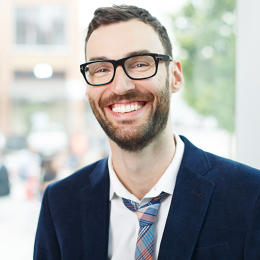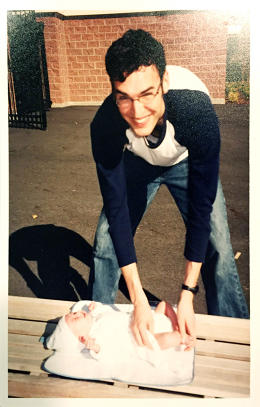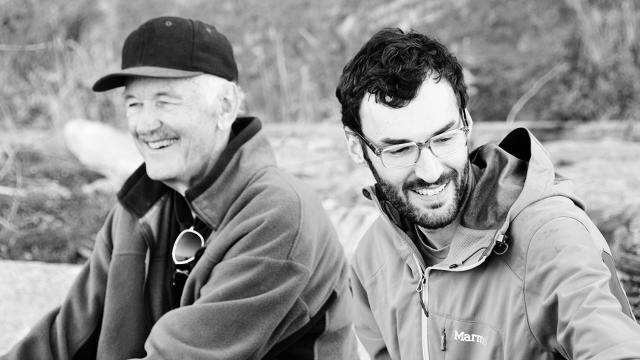How This Googler Redesigned The Workweek
Jake Knapp has always been concerned about the speed at which time passes.
Even back in his college years, he remembers thinking about how he wanted to get the most out of life. If this realization came earlier to him than to most, it may be because Knapp is the youngest of seven siblings. His father—with whom Knapp was always close—was already 47 when Jake was born. “I could see him getting older,” Knapp recalls now. “It made me more aware of life as something that passes by.”
“I kind of obsessed about it a little bit.”

Ahead Of The Curve
Maybe this is why Knapp got something of a head start on most phases of life. Work crashed in on his college years. He began doing web design for Oakley (the sunglasses company) in 1999, then took time off from the University of Washington to work at Microsoft in 2000. That was also the year he met Holly.
Knapp was at a barbecue and saw her from across the party. He thought she was beautiful. He didn’t work up the nerve to say hello, but he noticed that she seemed to know his friend Dave’s girlfriend. After the party, Knapp learned that the two were roommates. So he sent Dave to inquire if the mystery woman was single.
“She’s not interested,” Dave reported back. But Knapp persisted anyway, and one day in May of 2000, he tagged along with Dave to the women’s apartment. He and Holly hit it off.

More than that: They fell in love. “We just clicked,” says Knapp. They spent all their time together. By Thanksgiving, the families were meeting each other at the Knapp home on Orcas Island. One morning, as they were getting ready to go downstairs for breakfast, Holly pushed Knapp down onto the bed.
“Hey, will you marry me?” she said.
“Are you serious?” he asked.
“That’s your response? Of course I’m serious!”
“Yeah! Sure!” he said with a big smile.
It didn’t matter that they were 23. They knew.
Why wait? Knapp remembers thinking. Why waste any time?
“Those Hours Are Not Made Of Cardboard—They’re My Life”
Knapp went back to work at Microsoft, working on its encyclopedia product Encarta. Knapp loved his job. He’d been electrified by computers since he’d seen his first Apple II. He was a tinkerer who had always loved to make things. Designing Encarta felt like playing with Legos.
But soon enough Knapp was being promoted, and he started finding his days filled up with more and more meetings. The feeling of being able to dive into creative work faded. He had fewer hours to go deep.
Meanwhile, just two years into their young marriage, Knapp and Holly began discussing the feeling like there was someone missing from their family. By 2003, they had their first son, Luke. Again, despite being years ahead of their contemporaries, the decision, he says, “just seemed really clear.”

Knapp took three months of paternity leave, returning to Microsoft with a wildly different outlook on life. His time, already precious, was now even more so. The hours at work felt scarce. So did the hours at home. “There’s one bank account of hours in my whole life,” Knapp remembers thinking, “and I want to spend it well.” He would find himself in an interminable meeting, having just left his wife and son at home, and wonder, “Man, what am I doing here?”
He remembered something his father had once said: “Find a way to enjoy your work, because you’ll spend most of your life doing it.” Knapp recalls thinking, “Oh my God, most of my waking life will be spent doing work.” He didn’t want to just punch the clock from 9 to 5. Those hours are not made of cardboard—they’re my life, thought Knapp. “I realized I had to do everything I could to save my life at work,” he recalls.
He picked up David Allen’s famed productivity book Getting Things Done and read it three times cover to cover. One evening, he was so engrossed in reading it that he took the wrong bus home from work, winding up in a part of Seattle he’d never seen, and called Holly to pick him up. He experimented with every type of to-do list, all manner of productivity hacks.
And finally, after years of experimentation, Knapp came to feel he had mastered the use of his own time and priorities—except one: He was still working on a CD-ROM encyclopedia that was destined to lose to a free Internet encyclopedia that anybody could edit.
From Time Well Spent To The Art Of The Sprint
Even after Knapp moved to Google, in 2007, he was still wondering about that a lot. He’d grown obsessed with optimizing his own time—and had largely succeeded. But ultimately, he reflected, he had only become more efficient at working for a losing team. When he zoomed out far enough, Knapp could see that he hadn’t actually spent his time as optimally as he’d have liked.
But what if he could convince entire teams to rethink the ways they spent their time? Knapp sensed that team structures were less rigid at Google. This was also the heyday of its famed “20% policy,” whereby employees were offered up to one day a week to work on their own projects. So Knapp began using his own 20% time to start rethinking how teams could restructure their time and energies.
The upshot of Knapp’s investigations was the idea of a “sprint”: a five-day period in which a team can focus on problems, generate ideas, and test them within a standard workweek. (Knapp has written about the idea of the sprint in more detail on this site, and in March he published a book on the topic, along with two co-authors, both colleagues at Google Ventures. And in April he spearheaded a national “Sprint Week,” with more than 400 companies participating.) Setting deadlines, batching tasks, and dividing labor are key features of the sprint.

A major benefit of the sprint mentality, says Knapp, is that by channeling work energies into efficient weeklong bursts, he’s better able to free his attention on other weeks to spend with Holly, Luke, and now Luke’s five-year-old brother Flynn. “I feel like I’m much more present than I had been when Luke was that age,” says Knapp now.
He has also imported ideas from the “sprint” directly into family time. Undertaking a recent painting project with Luke, Knapp structured it like a miniature sprint—setting the deadline of an art show at a neighboring coffee shop.

Knapp’s father passed away last fall. Luke will soon turn 13, just a decade shy of when his own parents married. The earth keeps speeding stubbornly around the sun.
Despite feeling confident that he uses his time better than ever—despite having written the book on it—
(24)



